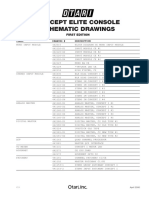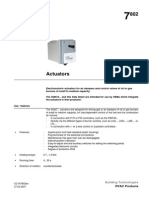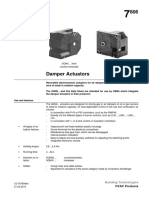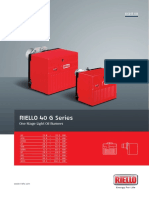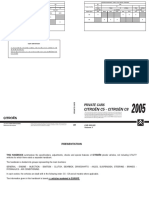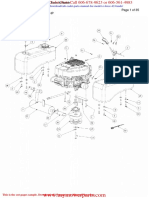LGB
LGB
Uploaded by
tespakCopyright:
Available Formats
LGB
LGB
Uploaded by
tespakOriginal Title
Copyright
Available Formats
Share this document
Did you find this document useful?
Is this content inappropriate?
Copyright:
Available Formats
LGB
LGB
Uploaded by
tespakCopyright:
Available Formats
7 435
Gas Burner Controls LGB...
ISO 9001
The LGB... are designed for use with gas burners of small to medium capacity,
with or without auxiliary fan, in intermittent operation*.
The gas burner controls are tested to EN298 and CE certified in compliance with
the directives for gas-fired appliances and electromagnetic compatibility.
* For safety reasons (self-test of flame supervision circuit, etc.), at least one controlled
shutdown must take place every 24 hours.
Use The burner controls LGB... are used for the startup and supervision of single- or two-
stage gas or gas / oil burners having a capacity of up to 350 kW in intermittent operation.
The flame is supervised with either an ionization current detector electrode, a blue flame
detector QRC1... for forced draught gas / oil burners, or a UV detector QRA... (with
auxiliary unit AGQ1...), depending on the type of burner control used.
When used with the appropriate adapters, these burner controls replace their
predecessors LFI7..., LFM1... and LFD... in terms of function and size (please also refer
to «Replacement types» under «Ordering»). Other application-related features:
– Detection of undervoltages in compliance with the respective standards
– Air pressure supervision with functional check of the air pressure monitor during startup
and operation
– Possibility of electrical remote reset
– Burner controls LGB41... for use with atmospheric gas burners
Landis & Staefa CC1N7435E June 10, 1997 1/18
Type summary The type references contained in the following table refer to burner controls with no base and with no flame
detector. For ordering information on bases and other accessories, please refer to «Mechanical design» through
«Flame supervision with UV detector QRA... and auxiliary unit AGQ... for LGB21.../ 22.../ 41...».
Flame detector Type reference Approved in: tw/s t1/s t2/s t3n/s t3/s t4/s t5/s 9) t10/s t11/s ³) t12/s ³) t20/s
ca. min. max. ca. ca. ca. max. min. max. max. ca.
Burner controls with air damper control for pre-purging with low flame air volume
Detector electrode (FE) LGB21.130A27 4)7) CH, EU, S, SF 8 7 3 2.4 2 8 - 5 - - 6
or UV detector QRA... LGB21.230A27 5) CH, EU, S, SF 8 15 3 2.4 2 8 - 5 - - 38
LGB21.330A27 5) CH, EU, H, S, SF 8 30 3 2.4 2 8 - 5 - - 23
LGB21.350A27 5)7) CH, EU, H, S, SF 8 30 5 4 2 10 - 5 - - 21
LGB21.550A27 5) AUS, CH, EU 8 50 5 4 2 10 - 5 - - 2
Burner controls with air damper control for pre-purging with rated air volume
Detector electrode (FE) LGB22.130A27 4) CH, EU, N, S 9 7 3 2.4 3 8 - 3 12 12 21
or UV detector QRA... LGB22.230B27 5) CH, U, N, S, SF 9 20 3 2.4 3 8 - 3 16.5 16.5 2
LGB22.330A27 5)7) AUS, CH, EU, H, 9 30 3 2.4 3 8 - 3 12 11 2
N, S, SF
LGB22.330A270 5)8) EU 9 30 3 2.4 3 8 - 3 12 11 2
Blue flame detector LGB32.130A27 4)10) CH, EU 9 7 3 2.4 3 8 - 3 12 12 21
QRC1... LGB32.230A27 5)10) CH, EU 9 20 3 2.4 3 8 - 3 16.5 16.5 2
LGB32.330A27 5)7) CH, EU 9 30 3 2.4 3 8 - 3 12 11 2
LGB32.350A27 5)7) CH, EU 9 30 5 4.4 1 10 - 3 12 9 2
Burner controle for atmospheric burners
Detector electrode (FE) LGB41.258A27 2)5)7) CH, EU, H SF 18 - 5 4 2 10 9 - - - 10
or UV detector QRA...
Legend tw Waiting time 2) For atmospheric burners up to 120 kW
t1 Checked pre-purge time 3) Maximum running time provided for the air
t2 Safety time damper actuator
t3n Post-ignition time 4) Also for flash steam generators
t3 Pre-ignition time 5) Also for stationary direct fired air heaters
t4 Interval BV1-BV2 or BV1-LR 7) Also available for 100...110 V; in that case,
t5 Second safety time (only with LGB41...) the last two digits read ...17 in place of ...27
t10 Specified time for air pressure signal 8) Without integral microfuse. Use only in
t11 Programmed time for opening actuator SA connection with a base AGK86... or with an
t12 Programmed time for closing actuator SA external microfuse of 6.3 A slow!
t20 Interval up to self-shutdown of the 9) t5 + reaction time of flame relay
programming mechanism 10) On request
2/18 CC1N7435E June 10, 1997 Landis & Staefa
LGB21... Flame supervision
Burner controls for single- or two-stage forced draught burners. LGB21...: with detector electrode or with auxiliary unit AGQ1...,
Air damper control for pre-purging with low flame air volume. for UV detector QRA...
Connection examples
Air damper control of two-stage or two-stage modulating burners.
Pre-purge (t1) with low flame air volume. Exactly the same low flame air
damper position (cam III) during startup and operation!
For detailed information about the air damper actuators, please refer to the
following data sheets:
SQN30...: data sheet 7808
SQN90.../ 91...: data sheet 7806
SQN3...121... SQN91.140.../two-stage control
* Note: in the case of two-stage modulating burners
(with gas regulation damper RV) BV2 and the connection
between the terminals marked (*) in the diagram are not required.
Burner without fan and without LP QRC1... with LGB3... (see above)
QRA... with auxiliary unit AGQ1... on LGB2.../LGB4... (see below)
bl blue
br brown
rt red
sw black
* With LGB41... terminal 3
Burner with fan control via auxiliary contactor (HS) with LP
Not valid for LGB41...
Landis & Staefa CC1N7435E June 10, 1997 3/18
LGB22.../32... Flame supervision
Burner controls for single- or two-stage forced draught burners. LGB22...: with detector electrode or with auxiliary unit AGQ1...,
Air damper control for pre-purging with high flame air volume. UV detector QRA...
LGB32...: with blue flame detector QRC1...
Only LGB22... Only LGB32...
Connection examples
Air damper control of two-stage or two-stage modulating burners.
Pre-purge (t1) with rated air volume.
For detailed information about the air damper actuators, please refer to
the following data sheets:
SQN30...: data sheet 7808
SQN90.../ 91...: data sheet 7806
SQN3...151... or SQN3...251... SQN90.220.../two-stage modulating control
Note: in the case of two-stage modulating burners (with gas
regulation damper RV), BV2 and the connection between the
terminals marked (*) in the diagram are not required
Legend
A Startup (controlled startup by «R») AL Fault status signal (alarm)
B-B´ Interval for flame establishment BV Fuel valves
C Running position of burner or enabling of second stage bv Auxiliary switch in the fuel valves (for closing check)
by load controller LR Dbr1 Wire link
D Controlled shutdown by «R» Dbr2 Wire link, required if contact «bv» or «zv1» is not present
tw Waiting time EK2 Remote reset button
t1 Checked pre-purge time FE Detector electrode
t2 Safety time FS Flame signal
t3 Pre-ignition time GP Gas pressure monitor
t4 Interval BV1-BV2 / LGB22.../ 32...: Interval BV1-LR HS Mains isolator
t5 Second safety time KL Low flame
t10 Specified time for air pressure signal L Live
t11 Programmed time for opening actuator SA LKP Air damper position
t12 Programmed time for closing actuator SA LP Air pressure monitor
Required input signals LR Load controller
Burner control output signals M Fan motor
N Neutral
R Control thermostat or pressure controller
SA Air damper actuator SQN...
zv1 Auxiliary switch in pilot gas valve VL High flame
ZV1 Pilot gas valve W Thermal reset limit thermostat or safety limit thermostat
Z Ignition transformer
4/18 CC1N7435E June 10, 1997 Landis & Staefa
LGB41... Burner controls for atmospheric gas burners with or without auxiliary fan. No air damper
control. Flame supervision with detector electrode.
Legend A Startup (controlled startup by «R») AL Fault status signal (alarm)
B-B´ Interval for flame establishment BV Fuel valves
C Running position of burner or enabling of bv Auxiliary switch in the fuel valves
second stage by load controller LR (for closing check)
D Controlled shutdown by «R» Dbr1 Wire link
tw Waiting time Dbr2 Wire link, required if contacts
t2 Safety time «bv» or «zv1» are not present
t3 Pre-ignition time EK2 Remote reset button
t4 Interval BV1-BV2 FE Detector electrode
t5 Second safety time FS Flame signal
HR Main burner
Required input signals HS Mains isolator
Burner control output signals L Live
M (Auxiliary) fan motor
• Connection of valves in the case of pilot N Neutral
burners with main flame supervision R Control thermostat or pressure controller
•• Connection of valves in the case of two-stage W Thermal reset limit thermostat or safety
atmospheric burners with supervision of the limit thermostat
first stage (BV1) Z Ignition transformer
ZR Pilot burner
ZV1 Pilot gas valve
zv1 Auxiliary switch in pilot gas valve
Landis & Staefa CC1N7435E June 10, 1997 5/18
Notes on the electrical installation of burner controls LGB...
To isolate the burner control from the mains network, an all-polar isolator with a contact
gap of at least 3 mm is required.
Switches, fuses, earthing, etc., must be in compliance with local standards and
regulations.
Protection against electric shock hazard on the burner control and on all associated
electrical items must be ensured by appropriate mounting.
The earthing lug in the terminal base must be secured with a metric screw and a lock
washer or similar.
The connection diagrams shown apply to burner controls with earthed neutral. In the case
of ionization current supervision in networks with non-earthed neutral, terminal 2 must be
connected to the earth conductor via an RC unit.
Part no. of RC unit: ARC 4 668 9066 0
The maximum permissible switching capacity of the connection terminals must not be
exceeded.
From externally, no mains voltage may be fed to the burner control´s control outputs. This
means that when checking the functioning of devices controlled by the burner control
(gas valves or similar), the burner control may never be plugged in.
In the case of burners with no fan motor, an AGK25.00A27 (230 V) or AGK25.00A17
(110 V)must be connected to terminal 3 of the burner control, or else, the burner
cannot be started.
For safety reasons, it is absolutely essential to feed the neutral wire to the neutral
distributor in the plug-in base or to terminal 2 and from there to the different units (fan,
ignition transformer and gas valves), or to an external neutral distributor.
Correct connection via the neutral distributor of the plug-in base:
Caution! Do not open the burner control!
Burner controls are safety devices.
Any unauthorized interference can result in unforeseen detrimental consequences!
6/18 CC1N7435E June 10, 1997 Landis & Staefa
Functions
LGB21... LGB22.../ 32... LGB41...
The function diagrams show the required or permissible input signals for the control part and the flame supervision circuit
hatched. If these input signals are not present, the burner control will interrupt the startup sequence and initiate lockout
where this is required by safety regulations.
The LGB... are capable of detecting undervoltages. This means that load relay AR will be de-energized if the mains
voltage falls below 160 V (for nominal 220...240 V) or 75 V (for nominal 100...110 V). The burner control will automatically
attempt a restart when the supply voltage again exceeds 160 V or 75 V respectively.
Conditions for burner – Burner must be reset
startup – The contacts of the gas pressure monitor «GP», of the thermal reset limit thermostat
or pressure monitor «W» and of the control thermostat or controller «R» must be
closed
– Fan motor must be connected
– Air pressure monitor must be in the idle position
Startup program A-C Startup program
A Start command (controlled startup)
This command is initiated by «R». Terminal 12 receives voltage and the
programming mechanism starts. After the waiting time «tw» with the LGB21... has
lapsed and after the actuator SA has driven the air damper to the high flame
position (that is, on completion of «t11») with the LGB22.../32..., the fan motor will
be started.
tw Waiting time
During this period of time, the air pressure monitor and the flame relay are tested
for correct contact positions.
t11 Programmed opening time for actuator SA
(Only with LGB22.../ 32...): the fan motor is started only after the air damper has
reached the high flame position.
t10 Specified time for air pressure signal
On completion of this period of time, the set value of air pressure must have built
up, or else lockout will be initiated.
t1 Pre-purge time
Purging the combustion chamber and the secondary heating surfaces: with low
flame air volume with the LGB21... and with high flame air volume (rated air
volume) with the LGB22.../ 32... The «Type summary», and the functional and
programming mechanism diagrams show the so-called checked pre-purge time
t1, during which the «LP» must indicate that the required air pressure has built up.
The effective pre-purge time comprises the interval end of «tw» / start of «t3».
Landis & Staefa CC1N7435E June 10, 1997 7/18
t12 Programmed closing time for actuator SA
(Only with LGB22.../ 32...): during «t12», the air damper travels to the low flame
position.
t3n Post-ignition time
Ignition time during the safety time. Just before reaching the end of the safety time
«t2», the ignition transformer is switched off. This means that the ignition time
«t3n» is somewhat shorter than the safety time «t2». This is necessary in order to
give the forcedly closed flame relay sufficient time to drop out if there is no flame.
t3 Pre-ignition time
During this period of time and up to the end of the safety time «t2», the flame relay
is forced to close. On completion of «t3», fuel release is initiated at terminal 4 or at
terminal 11 of the LGB41...
t2 Safety time
On completion of «t2», there must be a flame signal at input 1 of the flame signal
amplifier, which must be continuously present until controlled shutdown occurs, or
else the flame relay will be de-energized, the burner control will initiate lockout and
remain locked in the fault position.
t4 Interval
LGB21...: time to the release of the second fuel valve
LGB22.../32...: on completion «t4», the heat generating equipment is controlled in
function of the load (enabling of load controller)
LGB41...: time to the release of the second fuel valve
t5 Only LGB41...:
Second safety time for pilot burners with main flame supervision equipped with a
pilot gas valve «ZV1».
B-B´ Interval for flame establishment
C Running position of burner reached
C-D Burner operation (heat generation)
High flame operation or, in connection with a load controller, partial load.
D Controlled shutdown by «R»
The burner is immediately shut down and the programming mechanism is ready
for a new start.
Control program in the Basically, if there is a fault, the fuel supply is immediately shut down. If the fault condition
event of faults occurs at a time between start and pre-ignition, which is not indicated by symbols, the
cause is usually the air pressure monitor «LP» shutting down, or a premature (that is,
faulty) flame signal.
• After a mains voltage failure or in the event of undervoltage: startup repetition with
unabridged program
• In the event of a premature flame signal from the start of the pre-purge time:
immediate lockout
• In the event the contacts of the air pressure monitor «LP» have welded during «tw»:
no start
• If there is no air pressure signal: lockout on completion of «t10»
• In the event of an air pressure failure on completion of «t10»: immediate lockout
• If the burner does not ignite: lockout on completion of «t2»
• If flame is lost during operation: immediate lockout
Resetting the burner The burner control can immediately be reset after each lockout.
control
8/18 CC1N7435E June 10, 1997 Landis & Staefa
Lockout and control program indicator
Burner control The position of the programming mechanism can be viewed through the window on the
front of the burner control. In the event of a fault, the program mechanism is stopped and
thus the lockout indicator also. The symbol visible on the cam indicates both the position
in the program sequence and the type of fault according to the following legend:
No start because the start control loop is interrupted
Interval «tw» or «t10» (LGB21...)
Interval «tw» or «t11» (LGB22.../ 32...)
Interval «tw», «t3» or «t2» (LGB41...)
Air damper fully open (LGB22.../ 32...)
Lockout due to absence of air pressure signal
Interval «t1», «t3» and «t2» (LGB21...)
Interval «t1», «t3» («t12») (LGB22.../ 32...)
Release of fuel
Lockout because there was no flame signal on completion of the first safety time
Enabling of second fuel valve (LGB41...)
Enabling of load controller (LGB22.../ 32...)
Lockout because there was no flame signal on completion of the second safety
time (LGB41...)
Low or high flame operation (or return to the running position)
Mechanical design The burner controls are of plug-in design and very compact (measuring only
91 x 62 x 63 mm, including the base). The housing is made of impact-proof, heat-
resistant plastic and accommodates
– the programming mechanism with the synchronous motor
– the electronic flame signal amplifier with the flame relay and the other switching
devices
– the splashwater-proof lockout reset button with integrated fault indication lamp
The plug-in base is also made of impact-proof and heat-resistant plastic and can be
supplied either with screw terminals or clip connectors. The cable is introduced either
from the front or the side using the cable gland holder AGK65... or the cable holder
AGK66... . It can also be introduced from the bottom.
The two narrow sides of the base are provided with catches which engage in the housing
when the latter is plugged in. To disengage, a screwdriver must be slightly tilted in the
appropriate guiding slots.
Length and width of the base and location of the fixing holes and the lockout reset button
are identical with those of the predecessor units LFM... and LFI7... .
Landis & Staefa CC1N7435E June 10, 1997 9/18
Ordering Burner control (without base) refer to «Type summary»
Flame detectors
– Ionization current detector electrode delivered by others
– UV detector QRA... see data sheet 7714
– Blue flame detector QRC1... see data sheet 7716
RC unit for supervision of ionization current in networks with
non-earthed neutral ARC 4 668 9066 0
PTC resistor to generate load on terminal 3 AGK25.00A27 (230 V)
(compulsory with burners with no fan motor connected to
terminal 3) AGK25.00A17 (110 V)
Auxiliary unit for UV supervision
can be fitted under the AGQ1.1A27 (cable length 500 mm)
LGB... plug-in base, height 27.5 mm AGQ1.2A27 (cable length 300 mm)
Plug-in base, without cable gland and cable holder.
2 holes of 16.2 mm dia. for cable entry from below
– With screw terminals AGK11
– For clip connectors AGK12
Clips
– Separately, 100 pieces each AGK 4 408 5625 0
– On straps, 10,000 pieces each AGK 4 408 5626 0
Mounting / removal tool
– Mounting tool KF8883
– Removal tool KF8884
Cable gland holder, for 5 x Pg11, can be pushed into the base AGK65
Cable holder, can be pushed into the base, with 6 knockout cable entries
(without cable tension relief) of which there is 1 x 8.8/17 mm dia.,
entry on the side and 3 x 7 mm dia. and one rectangular opening 6 x 20 mm
on the front AGK66
Pedestal (empty housing) for increasing the height of the LGB... (62.5 mm)
to that of the LFM... or LFI7... (90 mm) AGK21
Service adapter with signal lamps for functional check, detector current
measurement, etc., of the burner control KF8872
Test case for checking the functions of the burner control KF8843
Adapters / replacement types for LFI7..., LFM1... and LFD...
(No rewiring required)
LGB21... with adapter KF8852 LFI7...
KF8880 LFM1...
KF8880 LFM1...-F
KF8857 LFD1...
LGB22... with adapter KF8853-K LFI7...
KF8880 LFM1...
LGB41... with adapter KF8862 LFM1...
KF8858 LFD2.35
10/18 CC1N7435E June 10, 1997 Landis & Staefa
Flame supervision with detector electrode
The conductivity and the rectifying effect of hot flame gases are used for flame
supervision. For this purpose, an AC voltage is applied to the heat-resistant detector
electrode which projects into the flame. The current which flows in the presence of a
flame (ionization current) produces the flame signal for the input of the flame signal
amplifier. The amplifier is designed such that it responds only to the DC current
component of the flame signal, thereby ensuring that no short-circuit can be simulated
between detector electrode and earth (since in that case an AC current would flow).
Basically, the flame supervision circuit is insensitive to adverse effects of the
ignition spark on the ionization current.
However, should these effects exceed a certain level, the electrical connections on
the primary side of the ignition transformer must be changed and / or the siting of
the ignition electrode against the ionization electrode is to be checked.
Ionization current supervision with 110 V burner controls
Since the ionization current with 110 V burner controls is only about 50 % of that with 220
V burner controls, it is sometimes necessary to increase it by means of a transformer.
Capacity of transformer: 2 VA min.; ratio approx. 1.1...1.5; primary and secondary
windings galvanically separated.
Connection of
transformer
Technical data
Burner control Mains voltage 230 V -15 %/+10 % (LGB32...!) Mains frequency 50 Hz -6 %...60 Hz +6 %
100 V -15 %...110 V +10 % Power consumption 3 VA
Radio interference protection N to VDE0875
Input current to terminal 12 5 A ¹) max. Primary fuse 10 A max., slow
Degree of protection IP40
Perm. loading on terminals Mounting position optional
- Terminal 3 3 A max.
(15 A during 0.5 s max.) Weight, without/with base approx. 230/310 g
- Terminal 4, 5, 7 2 A max. Weight AGK65... or AGK66... approx. 12 g
- Terminal 10 1 A max.
- Terminal 12 (at Umax. 264 V) 5 A max.
Identification code to EN298
Lenght of cable terminal 8 and terminal 10 20 m LGB21.../ 22...F T L L X N
with two-stage operation
LGB32... FMLLXN
with two-stage operation
LGB41... ABLLXN
with two-stage operation
(BV1+BV2 or ZBV+BV2)
AMLLXN
with single-stage operation
Environmental conditions CE conformance
- Transport IEC721-3-2 According to the directives of the European Community
Climatic conditions class 2K2 Electromagnetic compatibility EMC
Temperature -50...+60 °C 89/336 EEC includ. 92/31 EEC
Humidity < 95 % r.h. Gas appliance directive 90/396 EEC
Mechanical conditions class 2M2 Emissions EN 50081-1
- Operation IEC721-3-3 Immunity EN 50082-2
Climatic conditions class 3K5
Temperature -20...+60 °C
Humidity < 95 % r.h.
Condensation, formation of ice and ingress of water are not permitted.
Landis & Staefa CC1N7435E June 10, 1997 11/18
Flame supervision with blue flame detector QRC1...
The QRC1... has been designed specifically for blue burning flames. Light incidence is
from the front or the side. The detector is secured by means of a soft plastic plug.
Connection is made with a 3-wire cable (pre-amplifier integrated in the detector casing).
For design features and application, refer to data sheet 7716.
Operating voltage 230 V ±10 %, 50 Hz Power consumption 0.35 VA
Perm. detector current during Length of detector cable see data sheet 7716
pre-purge time (dark current) 5 µA Degree of protection IP40
Min. detector current required Perm. ambient temperature -20...+60 °C
during operation 50 µA (short-time 60 s max., 75 °C max.)
Weight (includ. 350 mm cable) 29 g
Measurement circuit M microammeter Ri 5000 Ω max.
bl blue wire
with blue flame detector br brown wire
QRC1... sw black wire
Flame supervision with UV detector QRA... and auxiliary unit AGQ... for LGB21.../ 22.../ 41...
UV detector QRA... Flame detector for universal use with gas and gas / oil burners. Light incedence from the
front or the side, total length 97 mm, available with normal or, as QRA2M, increased
sensitivity. Secured by means of a flange and clamp. Also available as a metal-
encapsulated version in the form of the QRA10.... For details, please refer to data
sheet 7712.
Auxiliary unit AGQ... When used in connection with burner controls LGB..., a special UV auxiliary unit AGQ... is
required. This unit is connected to the mains via two cables and to the burner control via
terminals 1, 2 and 11. There are two possibilities to check the arc-through tendency of
aging cells and the UV light, depending on the way the AGQ... is connected (refer to
connection diagram below):
A Operation with permanent phase
UV test by doubling the supply voltage (2 x UN = AC 460 V) across the UV cell on
startup (that is, until terminal 11 receives voltage) and after the controlled
shutdown.
B Operation with controlled phase
UV test by doubling the supply voltage on startup only, that is, during the interval
between controlled startup and air pressure signal. After a controlled shutdown,
there is no voltage across the UV cell. Since in that case an aged UV cell could
regenerate and the quench test would be eliminated, this version does not
represent a valid substitute for the above described operation «A» with permanent
phase.
AGQ1.1A27
AGQ1.2A27
A Operation with permanent phase
B Operation with controlled phase
* With LGB41...: terminal 3
12/18 CC1N7435E June 10, 1997 Landis & Staefa
Technical data Mains voltage 220 V -15 %...240 V +10 % Mains frequency 50 Hz -6 %...60 Hz +6 %
Power consumption 4.5 VA Radio interference protection N to VDE0875
Degree of protection IP40 Mounting prosition optional
Perm. ambient temperatures Weight approx. 140 g
- During operation -20...+60 °C - QRA2...; QRA2M... 60 g
- During transport and storage -40...+70 °C - QRA10..., QRA10M... 450 g
Max. perm. lenght of detector cable 20 m Max. perm. length of connecting cable 20 m
(use separate cable for connecting the UV detector AGQ1... to LGB...
QRA... to the AGQ1...)
Detector voltage with no load on the QRA... at mains voltage UN:
220 V 240 V
- Up to the end of «t10» and after controlled shutdown DC 620 V DC 675 V
- From the start of «t1» DC 300 V DC 300 V
Detector voltage (load by DC measuring instrument, Ri > 10 MΩ)
- Up to the end of «t10» and after controlled shutdown DC 500 V DC 550 V
- From the start of «t1» DC 280 V DC 280 V
DC current detector signals with UV detector QRA...
- a: measurement on LGB... 3 µA 15 µA
- b: measurement on UV detector 200 µA 500 µA
Measurement circuit
with UV detector QRA...
and auxiliary unit
AGQ1...
C electrolytic capacitor 100...470 µF; DC 10...25 V
M microammeter Ri 5000 Ω max.
bl blue
gr grey
sw black
Landis & Staefa CC1N7435E June 10, 1997 13/18
Electrical connection of ionization current and UV detectors
It is important that signal transmission will take place with the smallest possible
losses:
• With both ionization current and UV supervision, the length of cable for flame detection
may not exceed 20 m
• With both ionization current and UV supervision, the detector cable may not be run
together with other conductors in the same cable since line capacitances reduce the
magnitude of the flame signal
• The insulation resistance between detector electrode and ground must be at least
50 MΩ, even after an extensive number of operating hours. Prerequisite for this is not
only a high-quality heat-resistant insulation of the electrode cable, but also of the
detector electrode itself (ceramic holder)
• A dirty detector electrode holder offers favourable conditions for surface leakage
currents which reduce the magnitude of the flame signal
• The burner (as the counter-electode) must be correctly earthed, or else no ionization
current will flow
• Earthing of the boiler alone does not suffice!
• The line, neutral and central point conductors may not be incorrectly connected to
terminals 2 and 12 of the burner control, or else there will be no flame signal!
For electrical connection of blue flame detector QRC1..., please refer to data
sheet 7716.
Warnings • To protect the burner control from electric overload, both ignition and ionization
electrode must be located such that arcing over of the ignition spark to the
ionization electrode cannot occur!
• In the geographical areas where DIN standards are in use, the installatien must
be in compliance with VDE requirements, particularly with the standards
DIN/VDE0100 and 0722!
• Condensation and ingress of humidity must be avoided!
• Ignition cables must always be laid separately, maintaining the greatest
possible distance to the unit and other cables!
• Observe the notes on the laying of detector cables (refer to «Technical data»!
• The electrical wiring must be made in compliance with national and local
standards and regulations!
• LGB... are safety devices. It is therefore not permitted to open, interfere with or
modify the units!
• Check wiring carefully before putting the unit into operation!
• The unit must be completely isolated from the mains before performing any
work in the electronic connection area of the LGB...!
• Check all safety functions when putting the unit into operation or after changing
a fuse!
• Ensure protection against electric shock hazard on the unit and at all electrical
connections by appropriate mounting!
• Electromagnetic emissions must be checked from an application point of view!
• All regulations and standards applicable to the particular application must be
observed!
• Installation and commissioning work must always be carried out by qualified
personnel!
• The LGB... and this data sheet are intended for use by OEMs that integrate the
LGB... in their products!
14/18 CC1N7435E June 10, 1997 Landis & Staefa
Internal diagram and time diagram of programming mechanisms
LGB21...
AL Fault status signal (alarm) L Live
Legend AR Load relay with contact «ar» L1 Lockout warning lamp
BR Lockout relay with contact «br» LP Air pressure monitor
BV Fuel valves M Fan motor
Dbr1 Wire link MS Synchronous motor
EK Lockout reset button N Neutral
FE Detector electrode R Controle thermostat or pressure controller
FR Flame relay W Thermal reset limit thermostat or
GP Gas pressure monitor pressure monitor
HS Mains isolator Z Ignition transformer
1) The resistance between terminal 3 and N may not exceed 1.6 kΩ max.
Legend for diagram of A Start position (controlled startup) t2 Safety time
programming mechanism AR Load relay t3 Pre-ignition time
B Running position of burner t4 Interval BV1-BV2
C Running position of programming mechanism t10 Specified time for air pressure signal
or start position t20 Interval up to self-shutdown of
FR Flame relay programming mechanism
tw Waiting time T Total running time of programming
t1 Checked pre-purge time mechanism
I...IX Cam switches
Landis & Staefa CC1N7435E June 10, 1997 15/18
Only LGB22...
Only LGB32...
Legend AL Fault status signal (alarm) L Live
AR Load relay with contact «ar» L1 Lockout warning lamp
BR Lockout relay with contact «br» LP Air pressure monitor
BV Fuel valves M Fan motor
EK Lockout reset button MS Synchronous motor
FE Detector electrode N Neutral
FR Flame relay R Control thermostat or pressure controller
GP Gas pressure monitor W Thermal reset limit thermostat or
HS Mains isolator pressure monitor
Z Ignition transformer
1) The resistance between terminal 3 and N may not exceed 1.6 kΩ max.
Legend for diagram of A Start position (controlled startup) t2 Safety time
programming mechanism AR Load relay t3 Pre-ignition time
B Running position of burner t4 Interval BV1-BV2 or BV1-LR
C Running position of programming mechanism t10 Specified time for air pressure signal
or start position t11 Programmed time to open the damper SA
FR Flame relay t12 Programmed time to close the damper SA
tw Waiting time t20 Interval up to self-shutdown of
t1 Checked pre-purge time programming mechanism
I...IX Cam switches T Total running time of programming
mechanism
16/18 CC1N7435E June 10, 1997 Landis & Staefa
LGB41...
Legend AL Fault status signal (alarm) L Live
AR Load relay with contact «ar» L1 Lockout warning lamp
BR Lockout relay with contact «br» M Fan motor
BV Fuel valves MS Synchronous motor
Dbr1 Wire link N Neutral
Dbr2 Wire link terminals 6-2 required when contacts R Control thermostat or pressure controller
«bv» or «zv1» are not present W Thermal reset limit thermostat or pressure
EK Lockout reset button monitor
FE Detector electrode Z Ignition transformer
FR Flame relay ZR Pilot burner
GP Gas pressure monitor ZV1 Pilot gas valve in place of BV1 in case
HR Main burner of pilot burners with main flame
HS Mains isolator supervision
1) The resistance between terminal 3 and N may not exceed 1.6 kΩ max.
Legend for diagram of A Start position (controlled startup) t2 Safety time
programming mechanism AR Load relay t3 Pre-ignition time
B Running position of burner t4 Interval BV1-BV2
C Running position of programming mechanism t5 Second safety time
or start position t20 Interval up to self-shutdown of
FR Flame relay programming mechanism
tw Waiting time T Total running time of programming
I...IX Cam switches mechanism
Landis & Staefa CC1N7435E June 10, 1997 17/18
Dimensions
Burner control Burner control with base
AGK11... and cable gland
holder AGK65..., (can be
pushed into the base)
Base
AGK11... AGK12...
Plug-in base with screw terminals. Plug-in base for clip connections.
Hatched: position of cable gland holder or cable Hatched: position of cable gland holder or cable
holder, can be pushed into the base. holder, can be pushed into the base.
«B»: holes for cable entry. «B»: holes for cable entry from below.
«31», «32»: auxiliary terminals.
«N»: neutral terminals, connected to neutral input Connection choices:
(terminal 2). 1,3 a. 4 each 4 clips max. Earthing: total of 6 clips,
2 8 clips max. connected to lug «C»
Bottom: 4 earth terminals, joining a lug for earthing 5 through 10 3 clips max. for earthing the burner
the burner. 11, 12 each 4 clips max.
31, 32 each 2 clips max.
Mandatory: (AGK11... and AGK12...)
Connection of earthing lug «C» and of fixing screws
in «A» to the ground of the burner (using a metric
screw with lockwasher or similar!)
UV auxiliary unit AGQ1...
Type Dimension
reference
A B
AGQ1.1A27 500 19
AGQ1.2A27 300 34
1997 Landis & Staefa Produktion (Deutschland) GmbH
18/18 CC1N7435E June 10, 1997 Landis & Staefa
You might also like
- Westfalia Testing Repair ElectricalDocument1,049 pagesWestfalia Testing Repair ElectricalPaweł Korobajło100% (1)
- Concept Elite Console Schematic Drawings: First EditionDocument63 pagesConcept Elite Console Schematic Drawings: First EditionEduSantos Grammy WinnerNo ratings yet
- Albatros2 - Hydraulic Partial Diagrams and Auxiliary FunctionsDocument84 pagesAlbatros2 - Hydraulic Partial Diagrams and Auxiliary Functionsaenaos saNo ratings yet
- D3 D5 Installation ManualDocument48 pagesD3 D5 Installation ManualGert Koekemoer100% (1)
- Minisit 710Document8 pagesMinisit 710DraganNo ratings yet
- Schema Elettrico MontrealDocument1 pageSchema Elettrico Montrealiron93No ratings yet
- 2002 Peugeot 307 SWDocument137 pages2002 Peugeot 307 SWClaude SefakoNo ratings yet
- Wire Line Pipe Recovery Client Considerations PDFDocument6 pagesWire Line Pipe Recovery Client Considerations PDFAliNo ratings yet
- Chapter 5 Fuel Supply SystemDocument27 pagesChapter 5 Fuel Supply SystemFlanc100% (1)
- Project AIMA - Marketing Analysis of Havells India LTDDocument72 pagesProject AIMA - Marketing Analysis of Havells India LTDVikram ThakurNo ratings yet
- Software Version V03.00 CC1N7156en 24.07.2020: Smart InfrastructureDocument37 pagesSoftware Version V03.00 CC1N7156en 24.07.2020: Smart InfrastructureJoshua SanchezNo ratings yet
- Electromotoric Actuators For Air Dampers and Control Valves of Oil or Gas Burners of Small To Medium CapacityDocument11 pagesElectromotoric Actuators For Air Dampers and Control Valves of Oil or Gas Burners of Small To Medium CapacityalexjoelNo ratings yet
- Siemens Building Technologies: HVAC ProductsDocument10 pagesSiemens Building Technologies: HVAC ProductskevinNo ratings yet
- SQN 90 Dumper ActuarorDocument9 pagesSQN 90 Dumper ActuarorRomica CiorneiNo ratings yet
- Riello r40 G Ts0024uk04 Rev1Document24 pagesRiello r40 G Ts0024uk04 Rev1Patricio Fernandez BarbaNo ratings yet
- Burner Controls: Building Technologies DivisionDocument28 pagesBurner Controls: Building Technologies DivisiongigicorsicanuNo ratings yet
- LO550Document40 pagesLO550alejandro inocenteNo ratings yet
- Boiler and Burner Pieces - Boiler Parts - Boilerparts - Co.keDocument27 pagesBoiler and Burner Pieces - Boiler Parts - Boilerparts - Co.keboilerparts100% (1)
- SQN7 Actuators For Oil or Gas BurnersDocument21 pagesSQN7 Actuators For Oil or Gas BurnersMiguel Morales ChNo ratings yet
- Ducati Desmodromic Variable Timing (DVT) EngineDocument3 pagesDucati Desmodromic Variable Timing (DVT) EngineRushLaneNo ratings yet
- MCPP Series: Centrifugal Process PumpDocument8 pagesMCPP Series: Centrifugal Process PumpOmar SunasaraNo ratings yet
- 22 IPSOCD350EngDocument2 pages22 IPSOCD350EngFam PintilieNo ratings yet
- Manual de QuemadorDocument56 pagesManual de QuemadornetwalterNo ratings yet
- Siemens Sqn71 664a20 ManualDocument21 pagesSiemens Sqn71 664a20 ManualAntonio CanoNo ratings yet
- Ilus Cev1Document24 pagesIlus Cev1lionpjrNo ratings yet
- Databook CurrentDocument87 pagesDatabook CurrentAsad KhanNo ratings yet
- UntitledDocument4 pagesUntitledSusantaNo ratings yet
- KYMCO RACING KING 180i PARTS LISTDocument133 pagesKYMCO RACING KING 180i PARTS LISTdododo133No ratings yet
- Siemens SQN3x SQN4xDocument17 pagesSiemens SQN3x SQN4xclauNo ratings yet
- Despiece Riello 40G5Document4 pagesDespiece Riello 40G5Ignacio LopezNo ratings yet
- Exhaust Gas Heat Recovery Boiler: Aalborg AV-6NDocument2 pagesExhaust Gas Heat Recovery Boiler: Aalborg AV-6NGrover VillegasNo ratings yet
- 99 Magle Lapauw (Srednica Walca 900 1600 MM)Document15 pages99 Magle Lapauw (Srednica Walca 900 1600 MM)mandster1978100% (1)
- Man E0834 - enDocument4 pagesMan E0834 - enGolub MarkoNo ratings yet
- HT Metering Panel 11kv - RanconDocument1 pageHT Metering Panel 11kv - RanconDeshEnggNo ratings yet
- Adly 50 RS Parts ListDocument50 pagesAdly 50 RS Parts ListZsibrita GyörgyNo ratings yet
- TPS Especificacoes BOSCH Sensors - ThrottlepositionDocument3 pagesTPS Especificacoes BOSCH Sensors - ThrottlepositionLuiz Nogueira100% (1)
- Dish Dihr EnuDocument144 pagesDish Dihr EnuSaša LučićNo ratings yet
- CF Combi, SLB Leaflet, enDocument4 pagesCF Combi, SLB Leaflet, enFlorian_AngererNo ratings yet
- Catálogo de IrritecDocument164 pagesCatálogo de IrritecDaniel Alejandro GuerreroNo ratings yet
- Honeywell CS0162E-LS Rev.B СхемаDocument1 pageHoneywell CS0162E-LS Rev.B СхемаКоресендович ЮрийNo ratings yet
- Revue Technique Renault A310 A310 V6Document1,595 pagesRevue Technique Renault A310 A310 V6Jlp PierremontNo ratings yet
- Installation Module: Xarios RangeDocument20 pagesInstallation Module: Xarios Rangefaza1111No ratings yet
- Roland TR-808 Service ManualDocument16 pagesRoland TR-808 Service Manualboxertwin77No ratings yet
- Ee 670423 Ed BDocument68 pagesEe 670423 Ed Bdali2No ratings yet
- Chauffage Truma Trumatic E2800 4000Document12 pagesChauffage Truma Trumatic E2800 4000cpomaloNo ratings yet
- Ducati Superbike 1198 Owner ManualDocument141 pagesDucati Superbike 1198 Owner ManualJohn ConnorNo ratings yet
- SIT 845 IB Valve 05 - 06 PDFDocument63 pagesSIT 845 IB Valve 05 - 06 PDFFourati hassineNo ratings yet
- Qdoc - Tips - kw808 Manual KonnweipdfDocument72 pagesQdoc - Tips - kw808 Manual KonnweipdfMario Andres Cuevas TroncosoNo ratings yet
- Spark PlugDocument10 pagesSpark Plugdc mdNo ratings yet
- 0 0750 0043 02 WebDocument2 pages0 0750 0043 02 WebisaacNo ratings yet
- Comenda WarewashingDocument36 pagesComenda WarewashingEugen VasileNo ratings yet
- Hyd 6WL PDFDocument2 pagesHyd 6WL PDFEl Hadji Malick SyNo ratings yet
- MA - B008 - WF8 11 18 22 33 40 55 - AT - v00Document99 pagesMA - B008 - WF8 11 18 22 33 40 55 - AT - v00José RamosNo ratings yet
- 2CV EN 2013 91053 WebDocument348 pages2CV EN 2013 91053 Webaljaz.gmajnar4216No ratings yet
- ZXLE-050E-TFD-454 Spare Parts List: 230908 - Spac - 3 Sep 13, 2021Document5 pagesZXLE-050E-TFD-454 Spare Parts List: 230908 - Spac - 3 Sep 13, 2021AndreeaNo ratings yet
- Actuador Caldera SQN31.401 A 2760Document15 pagesActuador Caldera SQN31.401 A 2760Cesar OmarNo ratings yet
- 8 Inch SS 50 HZ CatalogueDocument12 pages8 Inch SS 50 HZ CataloguewagayeNo ratings yet
- Errecom Cat.a.05 19.enDocument88 pagesErrecom Cat.a.05 19.enkallatisNo ratings yet
- Citroen XM s2 Y4 MicrofilmDocument1,622 pagesCitroen XM s2 Y4 MicrofilmNacky100% (3)
- Bobinas PDFDocument8 pagesBobinas PDFLupe JimenezNo ratings yet
- Tutorial 6Document3 pagesTutorial 6An MohdNo ratings yet
- ArticleDocument14 pagesArticlejaime100% (1)
- Manual PROGRAMDOR Caldero AceiteDocument18 pagesManual PROGRAMDOR Caldero AceiteMiguel Morales ChNo ratings yet
- Fan Engineering Guide ERG100 PDFDocument12 pagesFan Engineering Guide ERG100 PDFtespakNo ratings yet
- Silicones in Industrial Applications Internet Version 080325Document106 pagesSilicones in Industrial Applications Internet Version 080325Jeevan PrakashNo ratings yet
- 16 4 Boston 04-72 0079 PDFDocument9 pages16 4 Boston 04-72 0079 PDFtespakNo ratings yet
- 3.7 Boiler Fittings and MountingsDocument14 pages3.7 Boiler Fittings and MountingstespakNo ratings yet
- tmg740 3Document6 pagestmg740 3tespakNo ratings yet
- Winco Dayton 3w056 3w057 Parts List 7 KWDocument4 pagesWinco Dayton 3w056 3w057 Parts List 7 KWtespakNo ratings yet
- 3.3 Water - Tube BoilersDocument153 pages3.3 Water - Tube BoilerstespakNo ratings yet
- QRAn 7712 eDocument8 pagesQRAn 7712 etespakNo ratings yet
- M 03904 CBDocument34 pagesM 03904 CBtespakNo ratings yet
- 440 STANDARD Operators Manaul 116-Pgs (Issue A1)Document116 pages440 STANDARD Operators Manaul 116-Pgs (Issue A1)tespakNo ratings yet
- LMV27Document17 pagesLMV27tespakNo ratings yet
- The Welding Handbook For Maritime WeldersDocument552 pagesThe Welding Handbook For Maritime WeldersLuciano SassoNo ratings yet
- Power Plant Process Flow ChartDocument1 pagePower Plant Process Flow ChartKeyur PatelNo ratings yet
- Start Inhibit FunctionDocument11 pagesStart Inhibit Functionlimkokchiang809No ratings yet
- C8 2005 PDFDocument357 pagesC8 2005 PDFRicardo SantosNo ratings yet
- Queue (Fifo-First in First Out)Document19 pagesQueue (Fifo-First in First Out)Santhoshkumar SethuramanNo ratings yet
- Cub Cadet Parts Manual For Model Z Force 42 BandsDocument3 pagesCub Cadet Parts Manual For Model Z Force 42 Bandsdorothy100% (57)
- Q Slope Mobile Phone App ManualDocument16 pagesQ Slope Mobile Phone App ManualShakeel AhmadNo ratings yet
- AMCRPS Piling Handbook9thDocument471 pagesAMCRPS Piling Handbook9thSamuel CancinosNo ratings yet
- 330part ListDocument168 pages330part ListFoto GrafNo ratings yet
- Pegatron T14NH REV 2.0 (Incompleto) PDFDocument5 pagesPegatron T14NH REV 2.0 (Incompleto) PDFDmitri Petrenko100% (1)
- Circuit Theory Question BankDocument11 pagesCircuit Theory Question BankJoshua DuffyNo ratings yet
- Its DTFT. First: Telephone Touch-Tone Will To DTFTDocument4 pagesIts DTFT. First: Telephone Touch-Tone Will To DTFTstephen562001No ratings yet
- Chip Formation and Tool LifeDocument37 pagesChip Formation and Tool LifeSquakx BescilNo ratings yet
- 4 ZXMSG 5200 (V2 (1) .0.2) Operation ManualDocument304 pages4 ZXMSG 5200 (V2 (1) .0.2) Operation ManualCélio Gomes Pereira83% (12)
- Abstracts - Employer - Employee RelationshipDocument3 pagesAbstracts - Employer - Employee RelationshipN.MUTHUKUMARAN67% (3)
- EZABL Pro Install Guide V1.2Document22 pagesEZABL Pro Install Guide V1.2Marco CisternasNo ratings yet
- Logarithmic Amplifier Design-WaVDocument6 pagesLogarithmic Amplifier Design-WaVnenabuleleNo ratings yet
- Caja de VacioDocument1 pageCaja de Vaciojaime huertasNo ratings yet
- Energy Efficiency Electronic Book Version 1548 - PowerGenerationHandbook v1 - 1Document362 pagesEnergy Efficiency Electronic Book Version 1548 - PowerGenerationHandbook v1 - 1avikrisadNo ratings yet
- Questions On DC MotorsDocument36 pagesQuestions On DC Motorskibrom atsbhaNo ratings yet
- Bti BX30Document1 pageBti BX30AS LO ProveedoresNo ratings yet
- Ezio-Manzini-Design, Social Innovation and SustainableDocument62 pagesEzio-Manzini-Design, Social Innovation and SustainablejannaynaNo ratings yet
- Kaydon Dry Gas SealDocument12 pagesKaydon Dry Gas Sealxsi666No ratings yet
- DLL Q4 Week 9Document69 pagesDLL Q4 Week 9Aiza ConchadaNo ratings yet
- V 100 KMHDocument40 pagesV 100 KMHHendry Nur ApriyantoNo ratings yet
- Mainboard 603tcfDocument20 pagesMainboard 603tcfHo Thanh BinhNo ratings yet
- How To Set Up A WRT54GS As A Repeater: Other People Are ReadingDocument5 pagesHow To Set Up A WRT54GS As A Repeater: Other People Are ReadingGilbertoReyesNo ratings yet
- An Introduction To The Design Methodology Of: Fb-DeepDocument75 pagesAn Introduction To The Design Methodology Of: Fb-DeepEmmanuel Garcia CarrascoNo ratings yet

